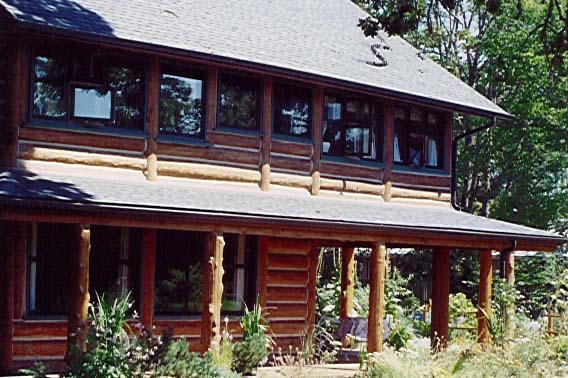
Weathering of wood is a combination of chemical mechanical biological and sunlight-induced processes that change the appearance and structure of wood. After two months of exposure all woods will turn yellowish or brownish and then gray. Dark woods will become lighter while light woods eventually darken. Surface checks raised grain cupping and warping develop as wood continues to weather.
Recent research conducted by the Forest Product Laboratory indicates that failure to properly treat new lumber can reduce the average life of wood by 20 percent.
Understanding the differences between finishes makes it easier to select the right product. In the past finishes were made from alkyd or natural oil resins such as linseed tung soya and paraffin. The resins were often blended with waxes to provide additional water repellency and then diluted with a mineral spirits solvent.
Technological advances and environmental regulations on emission level of volatile organic compounds (VOC’s) have spurred the development of new products. Water-based products particularly those formulated with certain water-reducible synthetic oils and resins have excellent penetration and perform as well as or better than oil-based (alkyd) finishes.
The performance of commercially available wood finishes is often listed on a product label or in literature supplied by the manufacturer. The American Society for Testing and Materials (ASTM) has standardized test methods to measure the water repellency and color retention of wood finishes.
In ASTM test D5401-93 a finish is applied to a 2″ by 4″ section of wood allowed to cure for seven days under controlled conditions and then tested for water absorbency. Standard ASTM G53-88 evaluates the water repellency of coatings exposed to ultraviolet light and condensation in a weather exposure chamber for 1000 hours. Manufacturers also use outdoor tests to measure weathering in various climates and they might provide test results if you request them.
Finishes are generally classified into two basic categories: those that form a film or coating on wood and those that penetrate.
Film Formers
These products form a coating or film that is a barrier between wood and the elements. Film-formers include many alkyds latex/acrylics and varnish resins in solvent or water-based finishes. Products without pigments are considered to be a clear or transparent finish and have little or not protection from ultraviolet (UV) radiation. Pigments are added to paints solid color stains and semi-transparent finishes to change the appearance of the wood and to provide protection from UV rays.
Some of the newer water-based coatings are semi-transparent acrylic blends that have excellent flexibility. Unfortunately due to their higher molecular weight acrylics still form a film on the surface of wood and are subject to the cracking that is characteristic of all film-forming finishes. A film finish cracks as wood expands and contracts during normal moisture cycling and water gets underneath the finish and deteriorates the wood. Removing film-forming wood finishes can be difficult but is often necessary before re-application. If the failing coat is not removed then the new coat may blister and peel.
Penetrating Finishes
Penetrating wood finishes are oil or water-based products that saturate wood pores to prevent water penetration. They typically contain a drying oil or resin in a transparent or semi-transparent stain. Advantages of penetrating finishes over films are that they provide long-term water repellency they do not trap moisture in the wood and they do not peel or blister.
Natural oils (linseed and tung for example) are initially very effective in stopping the absorption of water into wood but tend to darken over time because they are a food for fungi. Buildings treated with natural oils and resins generally need extensive cleaning before reapplying the finish.
Some of the newer water-based systems have synthetic oils and resins and they provide excellent water repellency and color retention. One of the main advantages of synthetic resins is that unlike natural oils they do not serve as a food for most biological growth making future coats easier to apply.
Applying the Finish
Correct application is critical to performance. Follow the manufacturers’ instructions particularly with the newer water-based formulations. All finishes should be applied to a clean surface but penetrating finishes must be applied to surfaces that are porous and free from previous coatings.
Although chlorine beach will effectively remove many stains like mold and mildew it can damage wood and is toxic to people and plant life. Newer chlorine-free cleaners are environmentally safe and can actually increase product penetration up to 25%. Wood that is pre-treated with a cleaner or pressure washer will probably have some raised grain but will also have a better finish penetration.
Water-based finishes tend to dry faster than oil-based products. To avoid lap marks particularly on hot sunny days apply these only in the shade: the cooler surface will absorb better and allow for easier application of a second coat.
Log structures can pose special application problems. Moisture contents higher than 20% can cause a finish to creak and peel as the log dries. Test logs with a moisture meter before applying or re-applying especially when using film-forming or water-based products.
Another problem is that the up-facing curves of logs are subjected to intense UV rays and moisture when when and snow accumulate in cracks and crevices causing the finish to crack and peel. Log homes at higher elevations are especially subject to temperature extremes that cause wood to continually expand and contract. This affects adhesion water repellency and color retention of finishes.
Exposed end grain at corners can encourage water penetration. Make sure that end grain is adequately treated and that large checks are sealed properly. Apply finish liberally to the courses of logs near the foundation where moisture and dirt are likely to be a problem.
Protecting logs from rain prolongs a finish and greatly reduces maintenance. Wide roof overhangs gutters and down spouts and good drainage around a foundation can help you avoid many problems. The combination of a high performance finish and good design and construction will help ensure that moisture does not deteriorate logs.
Maintenance
Routine maintenance is necessary but the life-span of a finish depends on a variety of factors. Construction details exposure to the elements product choice surface preparation and application techniques are all essential to success. Some finishes may even require chemical stripping or sandblasting to restore wood to the proper condition before re-treatment. Finishes that weather unevenly and are re-coated without removing the old finish will have an unsightly patchy appearance.
Although the wood finish is only a small percent of the cost of a log home it is one of the more critical elements in construction. To most consumers aesthetic appeal is just as important as performance when selecting a wood finish. Understanding the properties and expected performance of various products makes the decision process much easier for you.
Greg Herbert is a research chemist for SaverSystems a division of Meredith Inc. a manufacturer of finishes and water repellents for concrete masonry and wood. SaverSystems is the manufacturer of DEFY water based penetrating finish.
“








